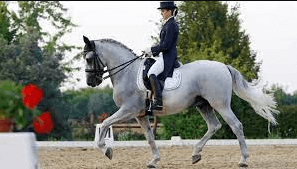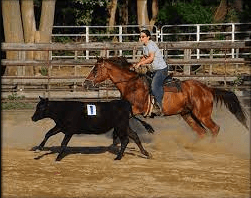What Are The Levels In Dressage Competitions?

Dressage competitions are a highly-regulated and structured equestrian sport that involves the training and presentation of horses in a series of progressively challenging movements. This article aims to provide an overview of the levels in dressage competitions, which are categorized based on the complexity and difficulty of the required movements. By understanding these levels, riders and enthusiasts can gain insight into the progression and skill development within this artful discipline.
At the introductory levels, riders focus on establishing a solid foundation for their horse’s training. This includes developing basic obedience, rhythm, suppleness, and contact with the bit. Introductory level tests involve straightforward movements such as circles, transitions between gaits, turns at specific markers, and simple lateral work. These tests aim to evaluate fundamental skills while allowing riders to demonstrate their ability to maintain harmony with their horse throughout their performance.
As riders progress through the intermediate levels of dressage competitions, they continue to refine their skills by incorporating more complex movements and exercises. At this stage, horses are expected to display greater impulsion (forward energy), collection (engagement of hindquarters), balance, and agility. The intermediate level tests often include more demanding figures such as half-passes (lateral movement at an angle) at trot or canter, flying changes of lead (changing leading leg during canter strides), extended gaits that showcase increased ground coverage while maintaining quality of movement.
In advanced levels of dressage competitions, both rider and horse reach a pinnacle of technical proficiency and athletic ability. The tests at this level require exceptional precision in executing intricate patterns with seamless transitions between movements. Advanced-level competitors must demonstrate mastery over advanced figures like passage (a highly collected trot with pronounced elevation), piaffe (a highly collected trot in place), pirouettes (turns on the haunches), tempi changes (frequent changes of lead every stride during canter), among others. Additionally, judges assess qualities such as expression, harmony, and overall artistic interpretation of the test. The advanced levels showcase the culmination of years of training and dedication, providing a magnificent display of equine athleticism and partnership between horse and rider.
In conclusion, dressage competitions encompass various levels that represent different stages of skill development and complexity in this elegant sport. From the foundational movements at the introductory levels to the awe-inspiring displays of technical precision and artistry at the advanced levels, each stage brings its own challenges and rewards. By understanding these levels, riders can set goals for their progression while retaining an appreciation for the beauty and grace of dressage.
Introductory Levels
Introductory levels in dressage competitions are the initial stages where riders and horses demonstrate fundamental movements, establishing a solid foundation for subsequent levels.
These levels serve as an introduction to dressage, allowing riders to develop their skills and horses to become accustomed to the demands of the sport.
Dressage training techniques play a crucial role in these levels, focusing on achieving harmony between horse and rider through precise communication and control.
Riders learn how to maintain correct posture, balance, and alignment while executing basic movements such as walking, trotting, and cantering.
They also practice transitions between gaits smoothly and effortlessly.
The emphasis at this level is on developing rhythm, relaxation, suppleness, contact with the bit, impulsion, straightness, and collection.
By mastering these core elements in the introductory levels of dressage competitions, riders lay a strong foundation for progression into higher-level competitions that demand more complex movements and greater precision.
Intermediate Levels
Intermediate levels in dressage competitions require riders to execute more complex movements and demonstrate a higher degree of precision and control compared to the earlier stages. At this level, riders are expected to have a solid foundation in the basic movements and be able to perform them with greater finesse.
The requirements for intermediate levels often include more advanced exercises such as half-passes, flying changes, and extended gaits. These movements not only test the horse’s athleticism but also challenge the rider’s ability to communicate subtle aids effectively.
To prepare for intermediate levels, riders must focus on refining their position and aids, as well as developing their horse’s strength, suppleness, and collection. Training techniques for intermediate levels may involve exercises that improve balance, flexibility, and responsiveness.
Additionally, riders must continue to work on establishing a harmonious partnership with their horse through clear communication and mutual trust. Overall, reaching the intermediate levels in dressage requires dedication, skill development, and a deep understanding of the artistry involved in this discipline.
Advanced Levels
At the advanced stages, riders are expected to showcase a mastery of intricate movements that demand exceptional precision and finesse.
Advanced level dressage tests require riders to demonstrate their ability to perform complex exercises such as piaffe, passage, flying changes, pirouettes, and half-passes.
These movements require the horse to be highly trained and responsive to subtle aids from the rider.
The piaffe is a collected trot in place, where the horse lifts its legs off the ground in a rhythmic motion.
Passage is an elevated trot with pronounced suspension and cadence.
Flying changes involve changing leads while maintaining rhythm and balance.
Pirouettes are tight turns performed at canter or collected canter.
Half-passes are diagonal movements where the horse moves sideways while maintaining forward momentum.
These advanced level movements not only require technical skill but also highlight the harmony between rider and horse.
Riders must have a deep understanding of their horses’ strengths and weaknesses in order to execute these exercises flawlessly.
Frequently Asked Questions
What type of horse is best suited for dressage competitions at the introductory levels?
The best horse breeds for dressage competitions at the introductory levels are those with natural athleticism, good movement, and trainable temperaments. Effective training techniques include consistent practice, correct positioning, and progressive exercises to develop balance, suppleness, and collection.
Are there any specific attire requirements for dressage competitions at the intermediate levels?
Attire requirements for dressage competitions at the intermediate levels typically include a formal dress code consisting of a white or light-colored shirt, stock tie or choker, dark coat, white breeches or jodhpurs, black boots, and gloves.
How are dressage competitions at the advanced levels scored?
Advanced level scoring in dressage competitions follows specific rules and guidelines. Judges evaluate the horse’s movements, precision, obedience, and overall performance. Scores are given for each movement, with deductions for errors or inaccuracies. The highest score wins the competition.
Can riders compete in both the introductory and advanced levels at the same competition?
Rider eligibility in dressage competitions varies depending on the competition rules. Some competitions allow riders to compete in both introductory and advanced levels, while others may have restrictions or require riders to choose one level for a specific competition.
Are there any restrictions on the use of training aids or equipment in dressage competitions at the intermediate levels?
At the intermediate levels of dressage competitions, there are certain restrictions on the use of training aids and equipment. These limitations ensure a fair and level playing field for all competitors, promoting the development of skill and technique in riders.
Conclusion
Dressage competitions consist of various levels that progressively increase in difficulty and complexity.
The first level is the Introductory level, which serves as a starting point for both horses and riders who are new to dressage. It focuses on basic movements such as circles, transitions, and simple changes of direction.
As competitors advance their skills and gain experience, they move on to the Intermediate levels. The Intermediate levels build upon the foundation established at the Introductory level by introducing more challenging movements and exercises. These include lateral work, collection, extension, and flying changes. Competitors must demonstrate greater precision and control in their riding abilities while maintaining harmony with their horse. The goal at this stage is to achieve balance, suppleness, and engagement from the horse.
Finally, there are the Advanced levels where riders showcase highly refined skills and techniques. These levels require exceptional precision, athleticism, and communication between rider and horse. Movements such as piaffe (a highly collected trot), passage (an elevated trot), pirouettes (tight turns in canter), tempi changes (flying changes every stride), half-passes (diagonal movements with sideways elements), and grand prix-level movements become part of the repertoire at this stage.
In conclusion, dressage competitions encompass three main levels: Introductory for beginners, Intermediate for those seeking further challenges after mastering basics; Advanced for riders displaying exceptional skills through intricate maneuvers like piaffe or passage. Dressage takes its participants on a journey of progressive difficulty where precision meets artistry – a symphony of movement between rider and horse that captivates audiences worldwide.

